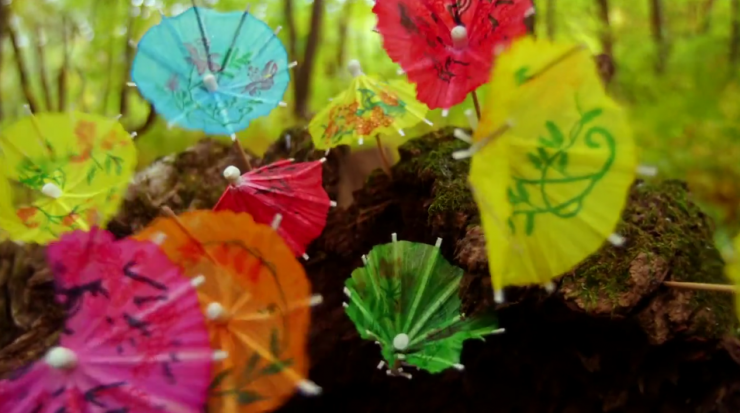“I wanted to depict the culmination of the circle-of-life of these tiny parasols.”
Despite its length, Forest Products offers up a lot to think about. At just 71 seconds, Eric J. Nelson‘s bite-sized “Wisconsin’s Own” selection blends lush nature photography with charming stop-motion animation, as a rainbow of parasols spring forth from moss logs and wind-swept fields. With eastern-tinged music from ViBRATiONLAND, another of Nelson’s homespun hobby horses, Forest Products is both a delightful hybrid of technique and a soft exercise in nature’s endless cycle.
For “5 Questions,” I talked with Nelson about his deceptively thorough micro-film:
1. What inspired you to mash up stop-motion and documentary?
The initial impetus for Forest Products came about with me playing with cocktail parasols that we had at home. As I was fidgeting with them, I thought it would be fun have to have them represent some blooming flowers in an animation.
That thought was mixed with my great admiration for the work of Blu, the street artist who animates large scale murals in decaying urban environments. You see real time passing in the periphery of Blu’s films, and I was really drawn to that effect. From there, I came to the conceit that my film would be a collection of staged, mock time lapses.
2. What with this taking place outdoors, I can’t imagine those tiny umbrellas were easy to hold in place.
The parasols had to be stuck into the earth, rotten wood, cracks in stone — wherever they could find enough purchase to allow me to manipulate them without unwanted movement. But even when driving in the points, the parasols would still shift and need repositioning at times.
3. What prompted your musical choices in Forest Products?
The score for Forest Products was inspired of course by the imagery, but also by the sweet and eerie music of One Flew Over the Cuckoo’s Nest. I am very fond of Jack Nitzsche’s slowly-building themes featuring the singing saw and Native American percussion, and I wanted to write something with a similar feeling.
4. Forest Products takes places over multiple seasons. Were you strategic in when and where you shot? Or did you just walk around with parasols in your pocket the whole time?
Shooting on Forest Products began in the spring of last year with the intent of capturing footage through all of the seasons. I would bring my camera gear and box of parasols with me when working on location, or family excursions and vacation, or on short day trips. It wasn’t a continuous effort but it was spaced throughout the year.
By late November, we hadn’t yet had a lasting snowfall, so I wasn’t able to shoot any winter scenes by the early December deadline for the Wisconsin Film Festival. The very elaborate and laborious set piece I had planned for the end of the film essentially got axed and replaced with a simplified and (I hope) better finale.
5. What was your final set piece originally going to be?
My original concept for the ending was an irony-free lift from a common nature documentary trope. I wanted to depict the culmination of the circle-of-life of these tiny parasols. The un-filmed winter scene of these organisms decaying or hibernating in the snow would lead to the next generation emerging in the spring. The plan was to acquire a full-sized paper parasol and animate it peaking through the soil and opening its canopy. Once fully deployed, the large parasol would dramatically release a cloud of “spores” which would then take root and open, completing the cycle.
I was very intimidated at the prospect of actually following through with that idea, knowing that it would be logistically very difficult for me to pull off working alone. The thought of simultaneously animating enough elements to form a cloud of spores was too daunting — so I was always chewing on other possibilities for the ending.
- Forest Products plays as part of the Wisconsin Film Festival’s opening night celebration on Thurs, Apr 14 at 5:30p at the Barrymore Theatre.

